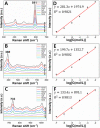SERS detection of surface-adsorbent toxic substances of microplastics based on gold nanoparticles and surface acoustic waves
- PMID: 38196907
- PMCID: PMC10774860
- DOI: 10.1039/d3ra07382c
SERS detection of surface-adsorbent toxic substances of microplastics based on gold nanoparticles and surface acoustic waves
Abstract
Microplastics adsorb toxic substances and act as a transport medium. When microplastics adsorbed with toxic substances accumulate in the body, the microplastics and the adsorbed toxic substances can cause serious diseases, such as cancer. This work aimed to develop a surface-enhanced Raman spectroscopy (SERS) detection method for surface-adsorbent toxic substances by forming gold nanogaps on microplastics using surface acoustic waves (SAWs). Polystyrene microparticles (PSMPs; 1 μm) and polycyclic aromatic hydrocarbons (PAHs), including pyrene, anthracene, and fluorene, were selected as microplastics and toxic substances, respectively. Gold nanoparticles (AuNPs; 50 nm) were used as a SERS agent. The Raman characteristic peaks of the PAHs adsorbed on the surface of PSMPs were detected, and the SERS intensity and logarithm of the concentrations of pyrene, anthracene, and fluorene showed a linear relationship (R2 = 0.98), and the limits of detection were 95, 168, and 195 nM, respectively. Each PAH was detected on the surface of PSMPs, which were adsorbed with toxic substances in a mixture of three PAHs, indicating that the technique can be used to elucidate mixtures of toxic substances. The proposed SERS detection method based on SAWs could sense toxic substances that were surface-adsorbed on microplastics and can be utilized to monitor or track pollutants in aquatic environments.
This journal is © The Royal Society of Chemistry.
Conflict of interest statement
There are no conflicts to declare.
Figures







Similar articles
-
Ratiometric SERS detection of polycyclic aromatic hydrocarbons assisted by β-cyclodextrin-modified gold nanoparticles.Mikrochim Acta. 2019 May 31;186(6):391. doi: 10.1007/s00604-019-3511-9. Mikrochim Acta. 2019. PMID: 31152234
-
Analysis of polycyclic aromatic hydrocarbons in water with gold nanoparticles decorated hydrophobic porous polymer as surface-enhanced Raman spectroscopy substrate.Spectrochim Acta A Mol Biomol Spectrosc. 2015 Mar 15;139:214-21. doi: 10.1016/j.saa.2014.11.104. Epub 2014 Dec 10. Spectrochim Acta A Mol Biomol Spectrosc. 2015. PMID: 25561300
-
Enhancement of photodegradation of polyethylene with adsorbed polycyclic aromatic hydrocarbons under artificial sunlight irradiation.Mar Pollut Bull. 2023 Sep;194(Pt A):115331. doi: 10.1016/j.marpolbul.2023.115331. Epub 2023 Jul 26. Mar Pollut Bull. 2023. PMID: 37499570
-
Strategies and Challenges of Identifying Nanoplastics in Environment by Surface-Enhanced Raman Spectroscopy.Environ Sci Technol. 2023 Jan 10;57(1):25-43. doi: 10.1021/acs.est.2c07416. Epub 2022 Dec 28. Environ Sci Technol. 2023. PMID: 36576086 Review.
-
Ecotoxicological effects of microplastics on aquatic organisms: a review.Environ Sci Pollut Res Int. 2021 Sep;28(33):44716-44725. doi: 10.1007/s11356-021-14982-4. Epub 2021 Jul 5. Environ Sci Pollut Res Int. 2021. PMID: 34226995 Review.
Cited by
-
Detection of Polystyrene Microplastics up to the Single Nanoparticle Limit Using SERS and Advanced ANN Design (KANformer).ACS Sens. 2025 Jul 25;10(7):4983-4995. doi: 10.1021/acssensors.5c00846. Epub 2025 Jun 25. ACS Sens. 2025. PMID: 40560738 Free PMC article.
-
Selective and Accurate Detection of Nitrate in Aquaculture Water with Surface-Enhanced Raman Scattering (SERS) Using Gold Nanoparticles Decorated with β-Cyclodextrins.Sensors (Basel). 2024 Feb 7;24(4):1093. doi: 10.3390/s24041093. Sensors (Basel). 2024. PMID: 38400251 Free PMC article.
-
Selective Identification and Quantification of Microplastics Using Solid Fluorescent Green Carbon Dots (SFGCDs) - A Novel, Naked Eye Sensing Fluoroprobe.J Fluoresc. 2025 Feb 27. doi: 10.1007/s10895-025-04152-x. Online ahead of print. J Fluoresc. 2025. PMID: 40014203
References
-
- Sharma S. Sharma B. Dey Sadhu S. Microplastic profusion in food and drinking water: are microplastics becoming a macroproblem? Environ. Sci.: Processes Impacts. 2022;24(7):992–1009. - PubMed
-
- Hong S. Shim W. Hong L. Methods of analyzing chemicals associated with microplastics: a review. Anal. Methods. 2017;9(9):1361–1368.
-
- Tien C.-J. Wang Z.-X. Chen C. S. Microplastics in water, sediment and fish from the Fengshan River system: Relationship to aquatic factors and accumulation of polycyclic aromatic hydrocarbons by fish. Environ. Pollut. 2020;265:114962. - PubMed
-
- Sharma M. D. Elanjickal A. I. Mankar J. S. Krupadam R. J. Assessment of cancer risk of microplastics enriched with polycyclic aromatic hydrocarbons. J. Hazard. Mater. 2020;398:122994. - PubMed
-
- Amelia T. S. M. Khalik W. M. A. W. M. Ong M. C. Shao Y. T. Pan H.-J. Bhubalan K. Marine microplastics as vectors of major ocean pollutants and its hazards to the marine ecosystem and humans. Progress in Earth and Planetary Science. 2021;8(1):1–26.
LinkOut - more resources
Full Text Sources
Miscellaneous

